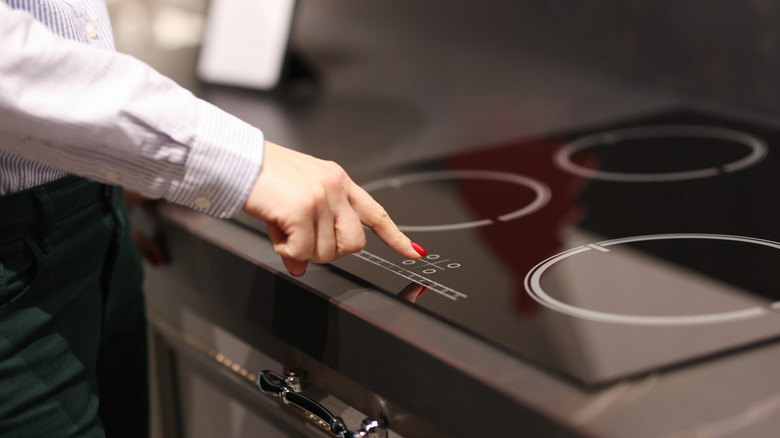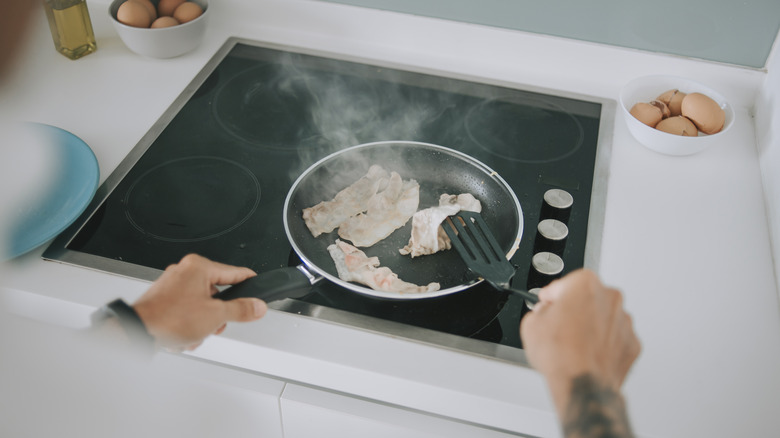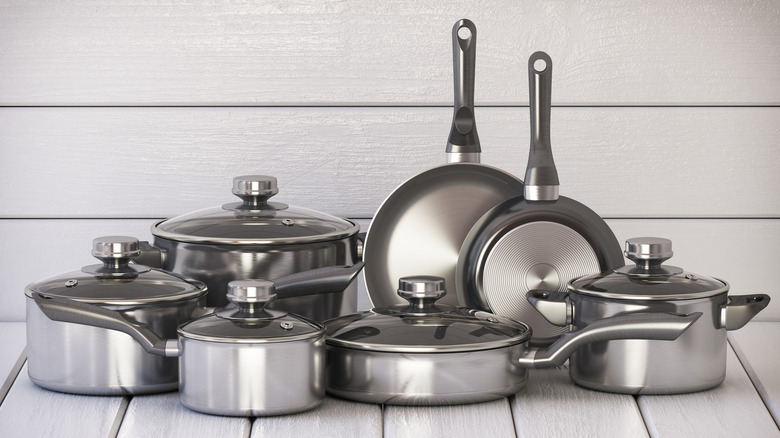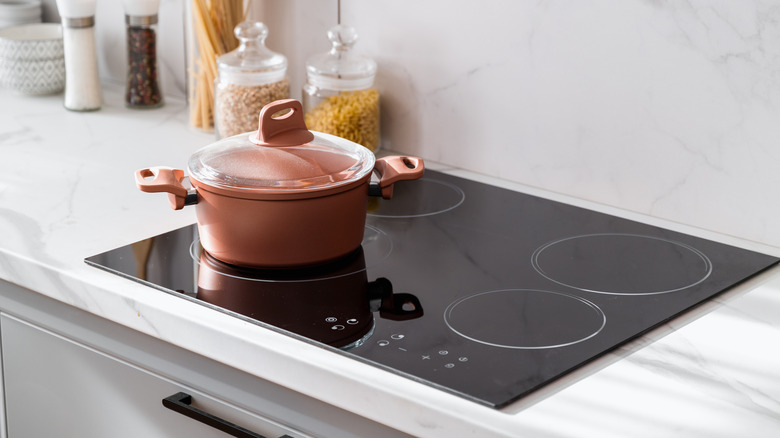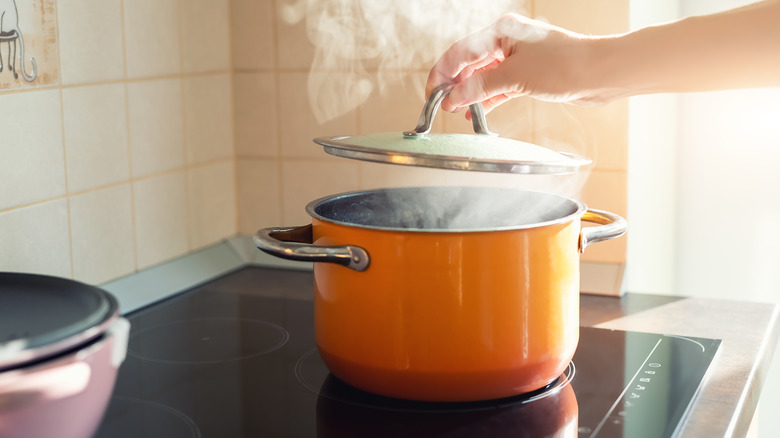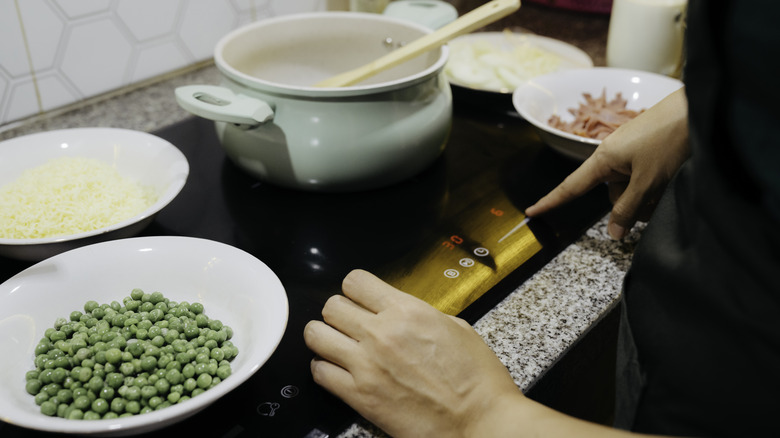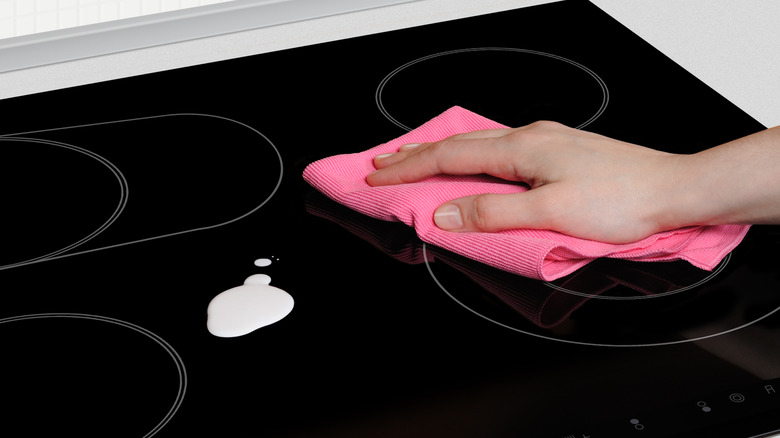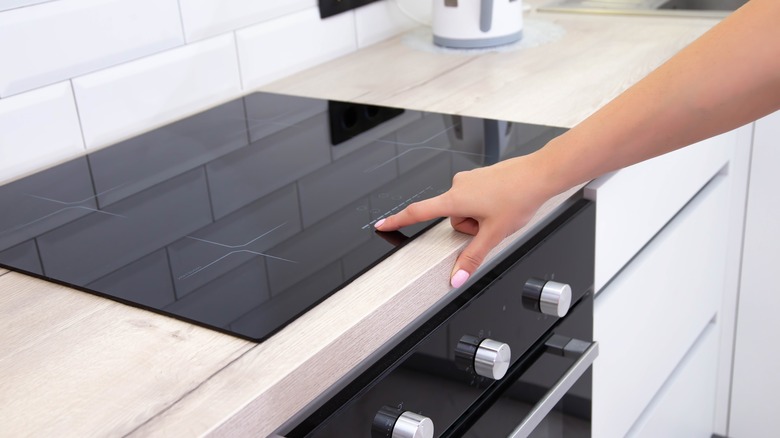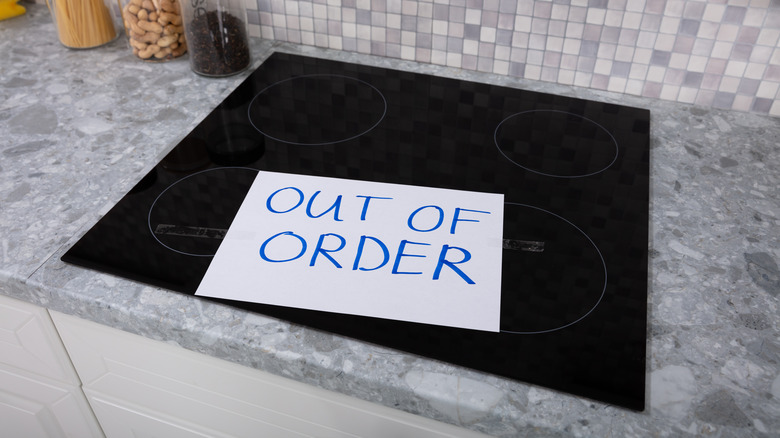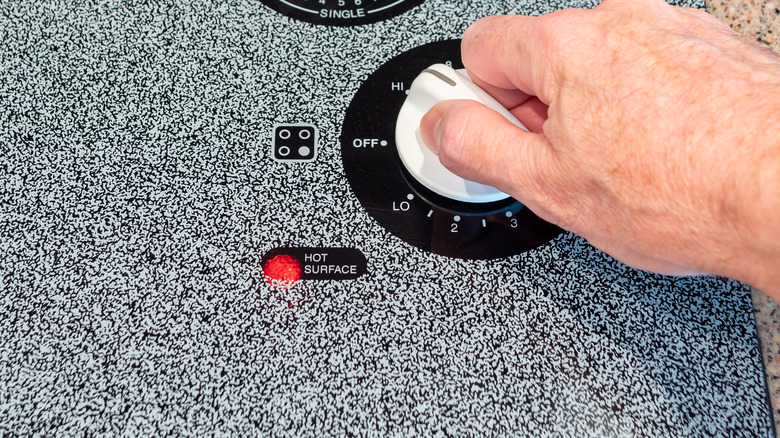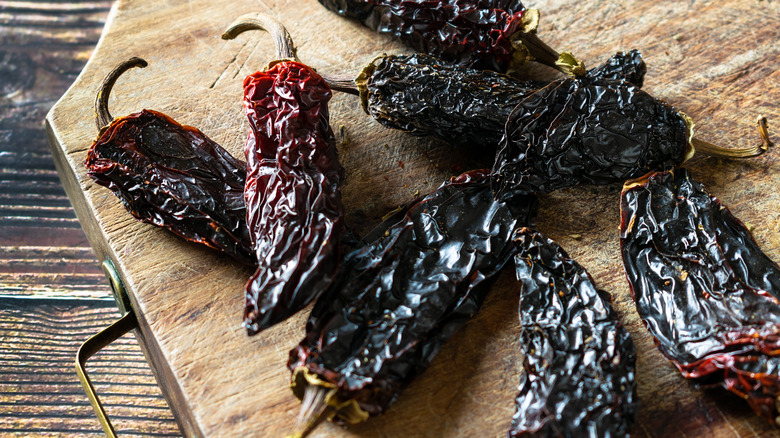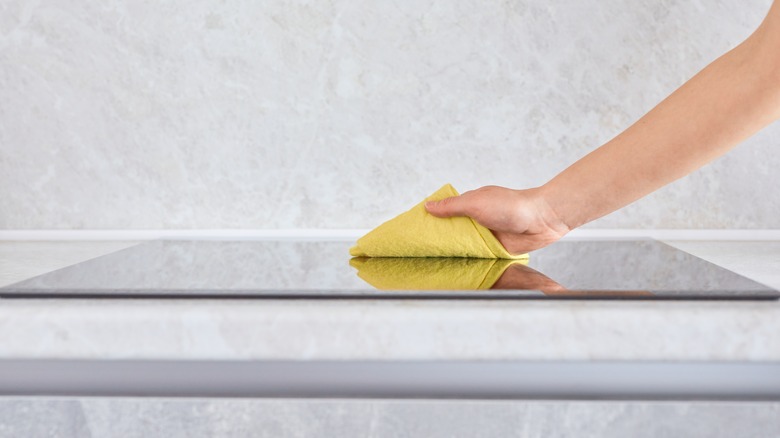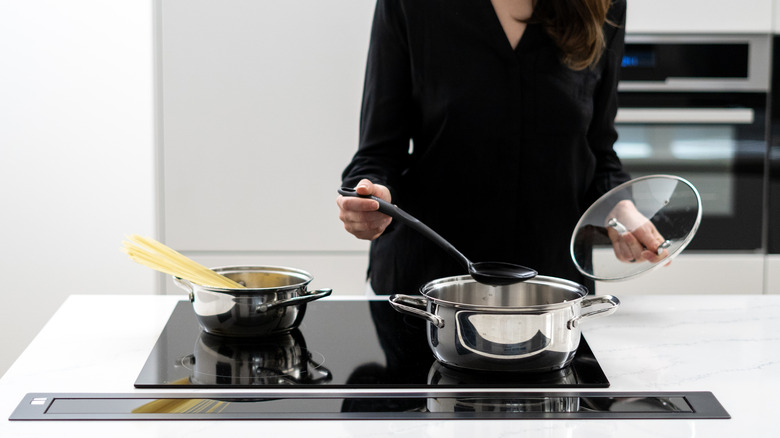12 Mistakes Everyone Makes When Cooking On An Induction Cooktop
If you haven't considered an induction cooktop, it's time to start thinking about one. Induction cooktops operate by creating an electromagnetic field to transfer energy directly to your cookware. When you place a magnetic pan onto an induction cooktop, it creates heat for the pan and the pan alone while everything around it stays cool. This technology comes with a wide variety of advantages. Not only are induction cooktops quicker to heat your pans than gas or electric alternatives, but they're also quicker to cool and way easier to clean, thanks to their flat design. Induction cooktops also tend to be more environmentally friendly than some other styles of cooking.
With these positives, though, come negatives — and one major downside is that induction cooktops are more likely to be misused. Although they're pretty easy to operate, people's unfamiliarity with induction technology can lead to them making simple but crucial mistakes like buying the wrong pans, using incorrect heat settings, or placing their cookware on the stove poorly. It's also easy to forget that not all foods cook the same on induction cooktops, and neglecting to change your recipes can ruin your meal. We're here to help you avoid these errors and use your induction cooktop with style.
1. Forgetting to read the manual before you first use it
Whether or not you've used an induction cooktop before, you should always be reading the manual before you fire it up for the first time. Your manual contains pretty much everything you need to know about how to operate your appliance, as well as crucial safety information. Importantly, some of this information is very specific and may not be things that you've considered with gas or electric stoves. If you have a pacemaker or hearing aid, for example, the electromagnetic frequency range of induction cooktops can interfere with their operation, and you may need to keep a greater distance, at least 2 feet, according to the British Heart Foundation, when cooking.
Instruction manuals also contain useful information about how to use your induction cooktop in the most energy-efficient manner, how to dispose of your packaging, and advice for the person installing the appliance on how to do so safely and efficiently. There are also instructions for helpful features like child lock and automatic warm-up functions. Instruction manuals also generally contain essentials like your model number, troubleshooting sections, and helpline numbers should your machine start malfunctioning. By reading this information ahead of time, you'll be safe in the knowledge that you fully know how your machine works, saving you trouble down the line.
2. Using the wrong pots and pans
One of the main errors people make when using induction cooktops is assuming that their regular cookware will function just as well. That couldn't be further from the truth. Your choice of pots and pans will, quite simply, make or break your induction cooktop's success, as they need to be made of magnetic materials to ensure that they interact with your cooktop properly and for the electromagnetic energy to transfer to and heat them.
Crucially, some of the most common cookware materials like aluminum, copper, and ceramics won't work with induction cooktops. Heat-resistant glass will also be ineffective, as it has no electromagnetic conducting power. Instead, your pans should be made from cast iron or enameled iron, magnetic stainless steel, or nickel. Remember that there's both magnetic and non-magnetic stainless steel, so ensure you're choosing the right one.
While some nonstick pans may work, it all depends on the material they're made from, and you'll need to make sure that they're not aluminum. You should also make sure that your pans are all flat-bottomed so that they can fully connect with the induction cooktop. This can be a particular problem for woks, so try to find a flat-bottomed wok specifically built for induction cooktops.
3. Putting your cookware on your cooktop incorrectly
To ensure that the energy from your cooktop can pass to your pots and pans seamlessly, you'll need a solid, consistent connection between the cooktop and cookware. However, this is something that all too many people get wrong. It's common for pots to be placed off-center of cooking zones and rings or for the pan you're using to be the wrong size for the cooking zone in the first place, creating an irregularity that will reflect how well your cookware can come up to temperature.
To avoid this, you need to place your cookware right in the middle of the cooking zone, in line with any rings or markers, and not hanging over any edges. Cooking zones on induction cooktops generally have several rings to indicate the minimum and maximum size of the pot you can use; aim for your pot's edge to be somewhere between the inner and outer rings. Food detritus or crumbs can also get between your pot and the cooktop, creating a gap between the two and stopping them from connecting properly, so ensure that your cooktop is smooth and clean before cooking.
4. Using the wrong heat settings
Induction cooktops can get pans very hot very fast, and being heavy-handed with your heat settings can create big problems. Because they heat cookware so quickly, setting your induction cooktop to the maximum setting may result in your food overcooking, burning, or cooking irregularly. In addition to this, whacking up your heat may, in worst-case scenarios, warp your pans, which may not have been built for such high temperatures.
It's worth remembering that induction cooktops can reach more than 650 degrees Fahrenheit, which is way higher than the temperatures gas burners produce. Induction cooktop heat settings are usually numbered from one to nine, with nine being the highest. Generally, you should only use the top setting for boiling water, and for everyday cooking, you probably won't have to go higher than seven. Luckily, pans are pretty responsive to changing heat settings if you need to reduce the temperature quickly. If you're new to induction cooking, it's a good idea to start slowly with heat settings and keep it low at first. Once you get acclimatized to how much temperature your appliance kicks out, you can start cranking it up when you need to.
5. Leaving food items on your switched-off cooktop
One of the main advantages of induction cooktops is how localized their heat production is. This means that unlike gas and electric stoves, which produce heat that radiates into your kitchen, induction cooktops transfer heat straight to your pan. Induction cooktop enthusiasts may tell you that this means that the appliance cools down immediately — but the truth is a bit more complicated than that. Because your cookware will retain the heat it receives from the cooktop, that heat can then transfer back onto your stove, warming up everything around it.
This can become an issue if, for example, you're taking a tray out of the oven and resting it on your still-hot cooktop or placing a cool, meltable item, like ice cream, onto the stove. In both of these cases, the residual heat may transfer to the new item, keeping it hot and cooking or melting it. More importantly, it can also create a safety hazard and burn your hand if you touch it immediately after turning it off. It's best to avoid placing anything on an induction cooktop cooking zone you've just used until it's completely cool.
6. Allowing spills to sit for too long
One of the best things about induction cooktops is their flatness, making cleaning spills as simple as wiping them away. Don't be tempted to leave spills for too long, though, as they can get in the way of your cooking. "Sugary spills can stick to the glass and create an uneven surface on your glass cooktop," explains Choice kitchen expert Fiona Mair. These can be almost imperceptible and won't create an obvious barrier between your pan and your cooktop or burn onto it like they would when using a gas or electric stove. They may, however, stop your pan from heating effectively and can become harder to clean off over time.
Importantly, this isn't just an issue for your pan's connection to your cooktop. Mair points out that spills or splatters can also end up on your touch controls, making it hard to turn the heat up, down, or off. You should always keep your touch controls clean when cooking and wipe any spills off as soon as they occur. For spills that end up directly in your cooking zone, it's usually best to wait until you've finished cooking and your cooktop is cool before wiping it off, as long as it's not getting in the way.
7. Overusing your boost function
If you're the kind of person who wants things done fast, your induction cooktop's boost function should be your best friend. Use it too often, though, and that friendship will sour fast. Boost functions (which are higher than the highest numerical setting and can also be labeled as "power" functions on certain appliances) are designed to heat your pans very quickly. This can be useful when you need to heat a food item immediately or bring a pan back up to temperature.
Use it too often, however, and you risk doing damage to your pans, or your kitchen. Some pans just aren't designed to withstand the temperature the boost function creates, leaving them misshapen or warped. That ultra-high heat can then affect your induction cooktop itself, leaving marks or damaging it and reducing its lifespan. Boost functions can also heat your food to a temperature that's quite frankly dangerous and can cause boiling water or oil to bubble over and damage your surfaces or even you. Therefore, only use your boost function sparingly and for a short amount of time — while some cooktops have an automatic shut-off function when things become too hot, yours may not do the same.
8. Cooking on a broken cooktop
Induction cooktop surfaces are generally made from glass-ceramic material and are tough and sturdy enough to handle even the heaviest pans. However, just like everything else, they can break. If a particularly hard and heavy object is dropped onto the cooktop, the glass-ceramic material can crack or shatter, and too-rapid fluctuations in temperature may also damage it. Any scratches to your cooktop can also develop and deepen over time, eventually leading to the cooktop splitting.
This is, of course, an issue in and of itself — but trying to cook on a damaged cooktop can create even more problems. Cracked induction cooktops can create a safety hazard and make cooking very risky, and they can also prevent your food from cooking properly and ruin the connection between your pan and your cooking zone. If your cooktop sustains any damage, you should stop using it immediately. Switch the cooktop off at the power source, unplug it, and arrange for a professional to replace or repair it as soon as possible. Don't be tempted to cook on any undamaged portions of the cooktop, as the damage may have impacted the interior function of the appliance.
9. Ignoring your safety lights
Induction cooktops come equipped with safety lights for a reason, and that reason is — you guessed it — to keep you safe. Many induction cooktops have a safety indicator that shows you when the surface is still hot. Sometimes, this is pretty clear, with the word "HOT" illuminating to indicate that things are still an unsafe temperature. Other times, it may show up as a red triangle or even just a simple light. These lights are particularly important to pay attention to, as induction cooktop cooking zones tend not to light up when they're in operation as they do on electric cooktops, which gives you a clear visual indicator that they shouldn't be touched.
Some induction cooktops also come with a child lock function that can be indicated by an illuminated key shape or, again, a single light. If there's any uncertainty about which light means what on your appliance, make sure to refer to your instruction manual. You should also pay close attention to whether these lights are coming on when they're meant to. If your heat indicator light doesn't illuminate when your cooktop is still hot, it could mean that your appliance needs a factory reset or has started to malfunction.
10. Forgetting to adjust your recipe
Cooking on an induction cooktop is not the same as cooking with gas, and this can be reflected in how your food turns out. It can be tricky, for instance, to achieve the smokiness that cooking on an open gas flame can give you by placing a metal grate above the flame and placing your ingredients onto it. As the only heat source you have with an induction cooktop is your pan, you'll need to get creative and adjust your recipe to accommodate for the difference in cooking technique with a new ingredient.
For smokiness, to keep with that example, try adding some chopped chipotle peppers or pepper flakes. As these have been smoked as part of their preparation, they'll give you all of their complexity with little effort. Smoked cheese, smoked oil, or even liquid smoke can also be thrown into your meal. It may also be worth thinking about how you can vary your cooking style for added smokiness by starting your food on an outside grill and then finishing it off on your induction cooktop or by using a specially designed induction griddle pan.
11. Cleaning it while it's hot
Knowing how to clean your induction cooktop is essential to keep it working for as long as possible, but not everyone does it right. The main mistake people make is cleaning it while it's still hot. "For induction tops, certain cleaning sprays and cleaning cloths may cause long-term damage to the cooktops if used when the burners are still on or too hot," registered dietitian Kelly Jones warns Allrecipes. Abrasive cleaning solutions and sprays full of chemicals are best avoided, as in addition to potential damage, they'll also fill your kitchen with foul-smelling fumes. Always opt for gentle and (wherever possible) natural cleaning products, like vinegar or baking soda.
You should also be very wary of using abrasive cleaning cloths, like those made of or containing steel wool. These can scratch your induction cooktop quickly, causing irreparable damage. Using polyester-based cloths when your cooktop is still hot may cause them to melt, fusing onto the appliance. As with your cleaning solutions, natural is best when it comes to your materials, with cotton cloths tending to work very well both for cleaning and drying your cooled-off cooktop. For especially stubborn dirt, rubber spatulas or specially designed scraping tools are usually the best way to go.
12. Trying to cook as if you have a gas stove
If you're moving to induction technology from gas, you may have to make a few adjustments to your cooking style. The main thing you'll have to change is how much you move your pan. While gas cooking might have seen you flipping and shaking your pans around like you're in an episode of "The Bear," induction cooking requires your pan to be in contact with the cooktop at pretty much all times to stay warm. You'll instead need to get accustomed to moving your food around with just your cooking spatula and only lifting your pan when you're ready to serve.
This isn't just important to keep your food cooking, too. If you're shaking your pan around on your cooktop, you run the risk of scratching its surface. Try also to remember that resting your cookware on your induction cooktop may cause issues where it didn't with your gas stove. If you're placing a metal spatula on the unused side of the cooktop, it may scratch its surface when you pick it up. As well as this, keep in mind that cooking times for your favorite recipe may vary significantly when switching from gas to induction.
